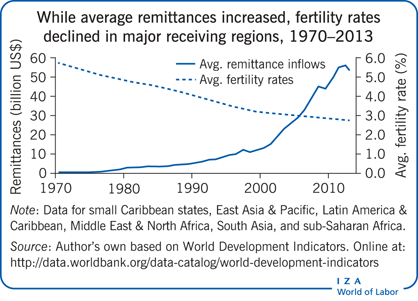Elevator pitch
The growth in the number and in the size of remittances and the stability of these monetary transfers have made them a prime target for policymakers. Because remittance flows go directly to households in emigrants’ home countries, one has to wonder about their effects on household decision-making, particularly in relation to the number of children to have. While this is household specific, when considered at the community and country level, there are significant policy implications for remittance-receiving economies. Therefore, it is crucial to more fully understand the relationship between remittance inflows and fertility rates.

Key findings
Pros
Remittance inflows increase fertility if children are considered a form of investment for future financial support (replacing social security).
By acting as an income boost, remittance inflows increase fertility if children are considered “normal goods.”
Remittance inflows allow receiving families to set up small, family-run businesses, which dictates the need for a larger family to secure future help.
Remittance inflows allow for the expansion of dwellings that could accommodate more children.
Cons
If a portion is spent on human capital development, such as nutrition, health services, and education, remittance inflows can decrease fertility.
Remittance inflows decrease fertility if children are considered “inferior goods.”
Remittance inflows mitigate against poverty, leading to lower fertility rates.
Remittances allow recipients to set up small, family-run businesses, which reduce the need for children as investments for the future and offer women work opportunities, reducing fertility rates.
Remittance inflows shape the type of migration that occurs by increasing the likelihood of brain drain, which reduces fertility rates.